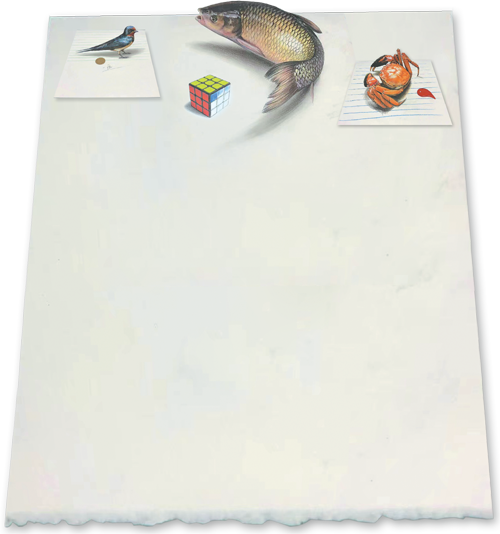When images come alive
Shanghai artist's mind-bending 3D paintings and easy online tutorials are taking the virtual world by storm, garnering millions of views, Yang Feiyue reports.

Nothing is unusual about Cao Zhi's workshop. Well, except for the giant cicada staring back at you or the frog squatting on his desk or the crab crawling near your feet.
As your mind contemplates fight or flight, the anamorphic artist assures you that the creatures are not real.
While you still find it hard to reconcile with "reality", Cao reassuringly rolls a pen on his 3D paintings or shakes the paper in the air to prove his point. As your heart finally stops racing, you blurt out compliments.
"The usual response (after I explain that these are just paintings) is a mix of surprise and admiration," the Shanghai painter says.
It is an understatement to say Cao's art, covering a broad range of subjects, is jaw-dropping. With a knack for perspective and a keen understanding of angles, he cleverly uses light and shadow to create mind-bending 3D images. From wildlife to humans, the talented artist can pretty much bring anything to life.
Cao's optical illusions look so real that a parrot ended up pecking at peanuts he had painted. Not to mention visitors trying to pick up the Rubik's cube on his desk or friends feeling tricked when they realize the platter of fruits is, well, just paper.
For perspective, the artist often places a coin or a lipstick near his larger-than-life images. "Creating 3D paintings requires patience and practice. The basic principle is to trick the mind, which interprets signals our eyes send," says the 40-something artist.
"Once the mathematical rules are mastered, innovative experiments can be done," he adds.
Cao's paintings have packed in more than 5 million fans on the popular short video platform Douyin. Many of his works have garnered more than 1 million views each, with the highest reaching 5 million.
Some cheeky fans even request Cao to paint 3D girlfriends for them. "I sometimes oblige them because I see it more as a test of my skills than a compliment," he says.
From doodling to creating
Cao was born in a rural household in Suqian, East China's Jiangsu province. "I had a knack for art since early childhood. I doodled whenever I could," he recalls.
He began basic training while in middle school and eventually took up art education at Suqian Higher Normal School in 1997.
After graduation, Cao taught at a local middle school for two years before he made his way to Shanghai in 2003. "I wanted to explore opportunities in a big city," he says.
He landed a job as a designer at an advertisement company and worked there for three years.
By 2007, Cao had gained adequate experience and saved enough money to open his own studio in the city. Business has been good, given that everyone in Shanghai-from children to adults-has a keen interest in art, he says.
The artist began uploading his conventional pencil drawings, mostly featuring profiles, flowers and small animals, in 2018.
"Livestreaming was a rage, and I dabbled in it for fun," Cao says, adding that he also hoped to increase his reach.
Gaining an audience was not all plain sailing. In fact, the turnout on the ground was disappointingly thin. Just when he was about to give up, Cao chanced upon anamorphic art, also known as 3D painting, online. "I had never seen anything like it before. It was mind-boggling and I wanted to give it a go," he recalls.
Cao figured out the math behind the concept of these lifelike images. Unlike two-dimensional objects that are flat, 3D objects appear to have volume, which indicates depth. He realized the illusion of depth can be created through various methods, particularly with the use of highlights and shadows.
"I told myself that if others can do it, so can I," he says.
Master and his followers
Revered as the inventor of 3D pavement art, Kurt Wenner's clever creations are a treat for the eyes. The US artist uses classicism and geometry in street paintings, which have been exhibited in over 30 countries.
Chinese 3D artists have been attracting global attention by winning consecutive listings in the Guinness Book of World Records. Beijing artist Qi Xinghua is often hailed as the man who introduced 3D street painting in China with his 2005 work called Whirlpool.
Qi held the record for the world's longest anamorphic painting. His work, Macao's One Impression, measures 128.7 meters and won the title in 2011.
But the genre was still new in the country. So, when Cao searched for online tutorials, he didn't find any comprehensive program. "The information was scattered. I had to piece things together and experiment one step at a time," he says.
Not to be deterred by challenges, Cao began practicing five to six hours a day, figuring out the differences between 3D and conventional art.
After rounds of trial and error, he found the key in the theory of deformation, which, he says, accounts for 70 percent of what it takes to make a 3D painting.
The technique of paper-cutting is sometimes applied to enhance the effect, he adds.
"To put it very simply, you need to draw your subject higher and longer," Cao says. "For example, the mouth of a cup is elliptical in 2D drawings, but should be round for a 3D effect. The subject must also have a bigger head and small bottom. Finally, you choose the right angle to take a photograph," he explains.
It took Cao more than a month to acquire working skills. He started with Chinese words before delving into more complex patterns. "No one was there to teach me. I had to explore on my own, so there were many detours. I guess the best way to learn the art is through constant study and practice," he says.
In late 2018, Cao released his first 3D work, a red rose, and it immediately drew more than 1 million views online. "It was a huge boost for my confidence, and I began spending more time perfecting the art," he says.
It takes Cao about five hours to finish a complex image, like a galloping horse.
In the past four years, he has created more than 300 anamorphic paintings. A growing fan base has also prompted him to start online tutorials.
"I am surprised that people from abroad also approach me for tips," he says.
Dong Xiaohong has been Cao's online pupil since May. "His method of teaching is so easy to understand, even for people like me with no prior art experience," she says.
A resident of Longkou city in East China's Shandong province, Dong joined Cao's tutorials after she painted a cucumber by watching his video and won praises.
"My friends thought it was a photograph," she says. "Cao helped me make the impossible possible."
Speaking about the future, Cao says he will continue making interactive 3D paintings for his audience.
"The objective is to pique interest and convey a message. Creating 3D art involves science and takes a great deal of patience, but if you are willing to put in the effort, the results can be stunning," he adds.


Today's Top News
- China-Cambodia-Thailand foreign ministers' meeting held, press communique issued
- Drills demonstrate China's resolve to defend sovereignty against external interference
- Trump says 'a lot closer' to Ukraine peace deal following talks with Zelensky
- China pilots L3 vehicles on roads
- PLA conducts 'Justice Mission 2025' drills around Taiwan
- Partnership becomes pressure for Europe






























